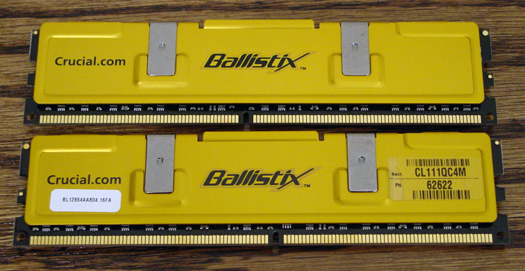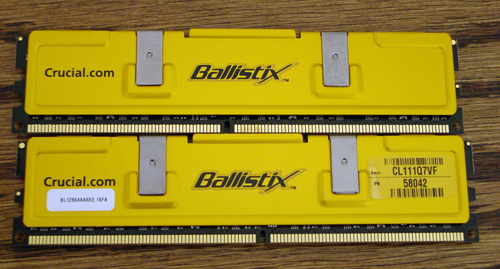Crucial Ballistix DDR2: The New DDR2 Standard?
by Steve Carmel & Wesley Fink on February 21, 2006 12:05 AM EST- Posted in
- Memory
Intel 975X Memory Test Configuration
Test Settings
All hard drives were completely formatted with a fresh OS installation. Four partitions were made, with one for the operating system, a small partition containing the paging file, an applications partition, and finally a storage partition. Using standard benchmark practice, all drives were defragmented after installation of programs and before any tests were run. Diskeeper 10 Professional Premier was the defragmentation program of choice.
Memory Module Information:
Crucial DDR2 PC2-6400
DDR2 testing on an Intel based platform proves to be a different beast entirely. Most enthusiasts know well the effects of brute force front side bus clocks, as the memory frequency produces a bigger effect on performance than does latency. It presents a bit of a conundrum as you can use different multipliers and memory ratios, either at a 1:1 ratio or up-clocked via the chipset memory strap. Ideally, a phase changed or water cooled solution might be best for testing, as one could use a 12X multiplier on the 955 EE, ramp the front side bus speeds up to 400 MHz, effectively running at DDR 800 in this manner. By maintaining this same strap during a review of DDR2 products on an Intel based platform, you would be able to see results more comparable to DDR memory testing on an Athlon 64 platform.
A remaining issue with Intel's 955 Extreme Edition processor is that the P4 Netburst architecture is still bottlenecked by its front side bus. Until Intel comes around to an integrated memory controller-type solution favored currently by AMD, it will be hard for them to be competitive on the memory latency front, as current generations of AMD processors have shown in a gaming or multi-tasked environment.
| Processor: | Intel 955 Extreme Edition at 13X Ratio (3.46 GHZ dual core 65nm CPU) |
| RAM: | Crucial Ballistix DDR2 PC2-5300 (2 x 1024 MB) Crucial Ballistix DDR2 PC2-6400 (2 x 1024 MB) |
| Hard Drives: | Maxtor DiamondMax Plus 9 160 GB ATA/133 - 8 MB Cache Seagate 7200.9 ST3500641AS SATA NCQ - 16 MB Cache |
| Video Card: | EVGA 7800 GTX KO 256MB |
| Video Drivers: | NVIDIA ForceWare Release 80/Version: 81.98 |
| Power Supply: | PC Power and Cooling Turbo-Cool 850-SSI |
| Operating System(s): | Windows XP Professional SP2 Windows XP Professional x64 Edition |
| Motherboard: | ASUS P5WD2-Premium |
| BIOS: | AMI version 0302 January 17, 2006 |
Test Settings
All hard drives were completely formatted with a fresh OS installation. Four partitions were made, with one for the operating system, a small partition containing the paging file, an applications partition, and finally a storage partition. Using standard benchmark practice, all drives were defragmented after installation of programs and before any tests were run. Diskeeper 10 Professional Premier was the defragmentation program of choice.
Memory Module Information:
Crucial DDR2 PC2-6400
- Part Number: BL2KIT12864AA804
- Module Size: 2GB kit (1GBx2)
- Package: Ballistix 240-pin DIMM
- Feature: DDR2 PC2-6400
- Configuration: 128Meg x 64
- DIMM Type: UNBUFFERED
- Error Checking: NON-ECC
- Speed: DDR2-800
- Voltage: 2.2V
- Memory Timings: 4-4-4-12
- Specs: DDR2 PC2-6400 (2.2V)

- Part Number: BL2KIT12864AA663
- Module Size: 2GB kit (1GBx2)
- Package: Ballistix 240-pin DIMM
- Feature: DDR2 PC2-5300
- Configuration: 128Meg x 64
- DIMM Type: UNBUFFERED
- Error Checking: NON-ECC
- Speed: DDR2-667
- Voltage: 2.2V
- Memory Timings: 3-3-3-12
- Specs: DDR2 PC2-5300 (2.2V)

DDR2 testing on an Intel based platform proves to be a different beast entirely. Most enthusiasts know well the effects of brute force front side bus clocks, as the memory frequency produces a bigger effect on performance than does latency. It presents a bit of a conundrum as you can use different multipliers and memory ratios, either at a 1:1 ratio or up-clocked via the chipset memory strap. Ideally, a phase changed or water cooled solution might be best for testing, as one could use a 12X multiplier on the 955 EE, ramp the front side bus speeds up to 400 MHz, effectively running at DDR 800 in this manner. By maintaining this same strap during a review of DDR2 products on an Intel based platform, you would be able to see results more comparable to DDR memory testing on an Athlon 64 platform.
A remaining issue with Intel's 955 Extreme Edition processor is that the P4 Netburst architecture is still bottlenecked by its front side bus. Until Intel comes around to an integrated memory controller-type solution favored currently by AMD, it will be hard for them to be competitive on the memory latency front, as current generations of AMD processors have shown in a gaming or multi-tasked environment.










27 Comments
View All Comments
leexgx - Saturday, February 25, 2006 - link
you Must understand the CPU that tomshardware got was an Test CPU, thay realy should of not done an benchmark as the CPU it self was not fully working and the DDR2 ram that was used was could only work at DDR2 666 and the timeings was stuck at 4-4-4-12 and may have been limted by the broken DDR2 contorler in it as well (you realy should look at it and not trust the resluts at all and thay have told you that its not to be trusted as well as its not an retail product as toms' stats)basicly at the time when P4 came to use DDR2 the timeing speed of DDR2 was silly DDR1 would out perform DDR2 this is why amd have not gone to DDR2 as ram speeds are now to the point where it will not be an bottle neck (and Ram price between DDR1 and 2 are not that must £10-£40 $40-$80 depending on size)
testing the Ram performance in am P4/P5 system is not usefull any way as it can not use it (get some intresting resluts when AM2 fully comes ot)
(the date is 06/06/06 when it comes out)
my self i am going to stick my AMD X2 3800+ 939 and mobo and 2Gb of ram in me server (board is dieing caps are leaking on this P4 mobo) and get AM2 when 65mm fabs come out for AM2 and fast ram by then (and some good mobos)
all that will probly be end of year i can wait my 3800+ X2 is running at 2.4ghz (basicly 4600+X2 as the ram is running at DDr480 as well)and its happy and cool keeps me happy
Jedi2155 - Sunday, February 26, 2006 - link
DDR1 outperforming DDR2 wasn't the main reason AMD didn't go to DDR2 right away. The main reason (if you read AMD's lawsuit against Intel's marketing practices) was because Intel created separate consortium to design DDR2 with the memory manufacturer's with the full intent of keeping AMD out of the loop. Thus AMD was a year or 2 behind Intel in developing the memory controller for DDR2 (as they couldn't see the specs till it was finished) nor did they have any input in the design of the specification.And thus DDR2 sucks more than it should had AMD been involved :)
DigitalFreak - Wednesday, February 22, 2006 - link
The AM2 platform launches on June 6, 2006 (6/6/6). Those aren't memory timings.Spacecomber - Tuesday, February 21, 2006 - link
I'll admit that I mostly skimmed through this article, but since much of the data seemed to be in the form of screenshots that are too small to be easily legible without cliking on them to get the enlarged version, I found it hard to get a quick glimpse of what this article might have to offer.I would much prefer results to be presented in traditional graphs and tables, instead.
Olaf van der Spek - Tuesday, February 21, 2006 - link
What is the information about the AMD CPU doing in this test?Too much copy/paste?
JustAnAverageGuy - Wednesday, February 22, 2006 - link
Yeah, that does seem out of place.Authors also need to go back and recheck their MB\GB , MHz\GHz labels. I sure don't want any 4.5MB\sec RAM.
96redformula - Tuesday, February 21, 2006 - link
My faith in crucial is gone.